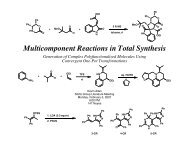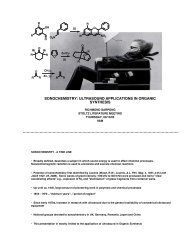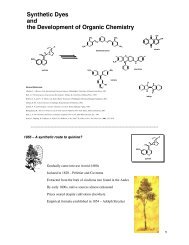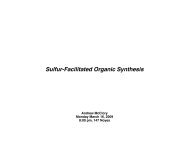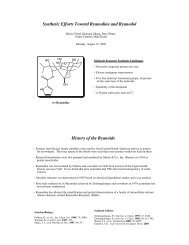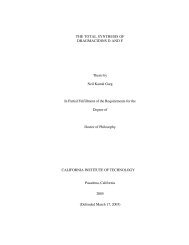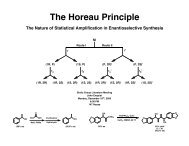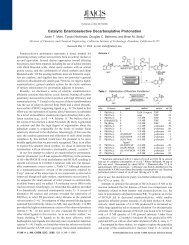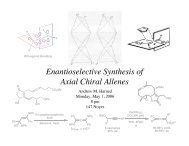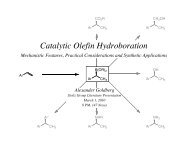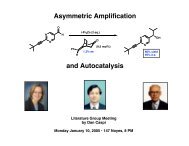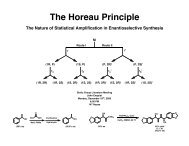Recent Developments in Aerobic Oxidation - The Stoltz Group
Recent Developments in Aerobic Oxidation - The Stoltz Group
Recent Developments in Aerobic Oxidation - The Stoltz Group
Create successful ePaper yourself
Turn your PDF publications into a flip-book with our unique Google optimized e-Paper software.
Flav<strong>in</strong>-Catalyzed Oxiation of Am<strong>in</strong>es and SulfidessubstrateoxidizedsubstrateNNONNONONOOHNOHONH +O 2H 2 ONHNONNONONH 2 O, N 2H 2 NNH 2 . H 2 ONONsubstrate product yieldONONO97SSNHSS ONO9785Imada, Y.; Iida, H.; Murahashi, S.-I. J. Am. Chem. Soc. 2003,125, 2868-2869.For autorecycl<strong>in</strong>g aerobic oxidation of some am<strong>in</strong>es see:Igarashi, K.; Yamaguchi, Y.; Mitsumoto, Y.; Naya, S.-I.; Nitta, M. J. Org.Chem. 2006, 71, 2690-2698.
<strong>Aerobic</strong> Baeyer-Villiger <strong>Oxidation</strong> of Ketonessubstrate product yieldOOO94OXHOOOXOOOOOX=HFCl78808483 (57:43)HOHOOHOHN NNOVitam<strong>in</strong> B 2NHOOOONNClO 4-NONO5-ethyl-3-methyl-2',3',4',5'-di-O-methyleneriobflav<strong>in</strong>iumperchlorateHexpectedunexpectedImada, Y.; Iida, Hiroki, Murahashi, S.-I.; Noata, T. Angew. Chem. Int. Ed. 2005, 44, 1704-1706.
Biomimetic <strong>Aerobic</strong> <strong>Oxidation</strong> of Am<strong>in</strong>es to Im<strong>in</strong>es
Interception of Im<strong>in</strong>esTrapp<strong>in</strong>g im<strong>in</strong>ium ion <strong>in</strong>termediates with carbon nucleophiles: Oxidative cyanationR 1N CH 2 R NaCNR 2RuCl 3.nH 2 O 5 mol%O 2 1 atmCH 3 OH/ CH 3 CO 2 HR 1NR 2CHRCNHCNR 1NR 2CHRCNR 1NR 2CH 2 RR 1N CHRR 2Ru n OHRu nR 1NR 2Ru nCH 2 RNCH 2 RRu n+2 OR 1N CHRR 2Ru n OOHR 1N CHRR 2Ru n HR 1NCHRHCNO 2R 2CNMurahashi, S.-I.; Komiya, N.; Terai, H.; Nakae, T. J. Am. Chem. Soc. 2003, 125, 15312.
<strong>Aerobic</strong> <strong>Oxidation</strong> of Am<strong>in</strong>es to NitrilesNH 22.8 mol % Ru / Al 2 O 35 mL PhCF 3NN100 °CO 2 1 atm93 %m<strong>in</strong>or side productH2.8 mol % Ru / Al 2 O 3N H5 mL PhCF 3N 99 % new catalyst, 2h99 % recycled catalyst, 2h100 °CO 2 1 atmNOHNH 2NH 2RuHAP, O 2100 °CTolueneRuHAP, O 2100 °CTolueneNH 2RuHAP, O 2100 °CTolueneOHNN96 %> 99 %>99 %CNOPHOOOClRuOORuHAPH 2 O, N 2 , 150 °COHPOONH 2RuHAP(calcium hydroxyapatiteCa 10 (PO 4 ) 6 (OH) 2 was stirredwith RuCl 3 )Yamaguchi, K.; Mizuno, N. Angew. Chem. Int. Ed. 2003, 42, 1480.Mori, K.; Yamaguchi, K.; Mizugaki, T.; Ebitani, K.; Kaneda, K. Chem. Comm. 2001, 461-462.Yamaguchi, K.; Mori, K.; Mizugaki, T.; Ebitani, K.; Kaneda, K. J. Am. Chem. Soc. 2000, 122, 7144.
Alkenylation of PyrrolesR 1NRR 1Pd(OAc) 2 (10 mol%)O 2AcOH:Dioxane:DMSO, 35 °CNRR 1NRR = BocR = TIPSR 1 =CO 2 BnCO 2 Bn (Air)CO 2 n-BuSO 2 Me4-(CO 2 Me)PhYield of C 273 (73)7273 (75)38 (69)53 (60)Yield of C 375 (78)7573 (81)45 (71)58 (63)* yields listed <strong>in</strong> parentheses are from us<strong>in</strong>g tBuOOBz as a stoichiometric oxidantus<strong>in</strong>g tBuOOBz as an oxidant trisubstituted alkenes could be generated <strong>in</strong> moderate yields (~ 60%)NTsOn-C 3 H 7electronic controlRNCO 2 Rsteric controlEtOONTIPS60% 66%Beck, E.; Grimster, N.; Hatley, R.; Gaunt, M. J. J. Am. Chem. Soc. 2006, 128, 2528 - 2529.
Pd-Catalyzed Carbonylative CyclizationRNHOTMSR 1Pd/C (10 mol%)KF (1.5 equiv)Bu 4 NI (1.0 equiv)CO: air (24 bar, 3:1)MeOH/MeCN, 65 °CRNCO 2 MeOR 1RMeO 2 CNOR 1RNHOR 1R 1 R 2 Z E desilylationHCO 2 MeCNClMeHHPhPhPhPhPh-NHPh-NHCH 2 Ph76537875646840055744235412 Costa, M.; Della Cà, N.; Gabriele, B.; Massera, C.;Salerno, G.; Soliani, M. J. Org. Chem. 2004, 69, 2469 -2477.Bacchi, A.; Costa, M.; Della Cà, N.; Fabbricatore, M.;Fazio, A.; Gabriele, B.; Nasi, C.; Salerno,G. Eur. J. Org.Chem. 2004, 574-585.HSiMe 3nBuPhOHRPdI 2 (1 mol%)KI (10 mol%)CO: air (4:1)MeOHMeO 2 C1972415OR174422ROCO 2 MeRMeOO710CO 2 Me3625CO 2 MeOR
Heck Coupl<strong>in</strong>g….Ar B(OH) 2 CO 2 BuPd(OAc) 2 (2 mol%), NMM (2 equiv)ligand (2.4 mol%)air, MeCNArCO 2 Buarylboronic acid % yield temp. (°C)B(OH) 28280OMeOOB(OH) 281rtNNB(OH) 281rtligandB(OH) 2AcB(OH) 2B(OH) 2AcSB(OH) 26467615080rt8080Enquist, P. E.; L<strong>in</strong>dh, J.; Nilsson, P.; Larhed, M. Green Chem., 2006, 8, 338 -343.
Oxidative Heck Reaction: Alkenyl BoronicCompoundsn-BuBOO Pd(OAc) 2Na 2 CO 3 , DMAO 2 , 23 °Cn-BuRolef<strong>in</strong> product % yieldCO 2 Etn-BuCO 2 Et79CO 2 tBun-BuCO 2 tBu81Phn-BuPhn-BuPh88 (8.8:1)PhOn-Bun-BuPhOn-BuPh84 (1:3.7)76CO 2 tBuPd(OAc) 2 (2 mol%)slow addition of boronic acidsPhBO86%OOBO91%TBDPSO87%BOOOTMS91%BOOPhOHBOH85%Yoon, C. H.; Yoo, K. S.; Yi, S. W.; Mishra, R. K.; Jung, K. W. Org. Lett., 2004, 6,4037 -4039.
<strong>Aerobic</strong> Enantioselective Heck-Type ReactionF 3 CB(OH) 2CO 2 RPd(OAc) 2 (5 mol%)(S,S)-chiraphos (5.5 mol%)DMF, O 2 , 50 °CF 3 C∗CO 2 RR % yield % eeMeMe aEtI-PrPhBn732572493158465946352249arun <strong>in</strong> MeOHPPdPPPPdPPdPCO 2MePPPdCO 2 MeAkiyama, K.; Wakabayashi, K.; Mikami, K. Adv. Synth. Catal., 2005, 347, 1569 -1575.
Cross-Coupl<strong>in</strong>g: StannanesRalkenePhSnBu 3 , Pd(OAc) 2Oxidant, NaOAc, rtCuCl 2THFRO 2DMFPhtBuO 2 CArSnBu 3 , Pd(OAc) 2Oxidant, NaOAc, rtRArPhSN0620827251MeOarylOMeSnBu 3CuCl 2THF96O 2DMF98F 3 CO6555OHCSnBu 38569Br080SnBu 36060OPhOOO65817067MeOBu 3 Sn7568OHCN6088Parrish, J. P.; Jung, Y. C.; Sh<strong>in</strong>, S. I.; Jung, K. W. J. Org. Chem. 2002, 67, 7127 -7130.
Generation of HeterocyclesOOOOTsOTsTsONNNOOOOONMe 2OONMe 2NMe 2NMe 2O ONMe 298NTsO ONMe 296OO ONMe 2Ts N91OOTsNNMe 262LAOOOD DOODO ONMe 2OD DPdCl 2NMe 2OONMe 2> 95% D D D> 95% DO OONMe 2NMe 2D> 95% D 90% DPd(0)ODPd(H)Cl]ODONMe 2Yb(OTf) 3 (1 equiv)PdCl 2 (MeCN) 2 (10 mol%)THF, O 2 (1 atm), rtODDNMe 2PdCl 2HClOOH 2 O 22HCl+ O 2OOHClOOYip, K.-T.; Li, J.-H.; Lee, O.-Y.; Yang, D. Org. Lett. 2005, 7, 5717-5719.ODDPdClNMe 2ODDNMe 2Pd(H)ClODDPdClNMe 2
Oxidative CyclizationsubstrateproductyieldPhOHOPhOO79%10 mol% PdCl 2 , 1 atm O 210 mol% CuCl, 10 mol% Na 2 HPO 4DME, 50 °CPhOHOO0%PhOHOHOOPhOHOOPhO60%1:4uncyclized:cyclizedPhee > 97%PhO61%ee > 97%R 2Pd(TFA) 2 (5 mol%)ligand (6 mol%)DMAP (20 mol%)Na 2 CO 3 (2 equiv)R 1R 1 O O R 2OH2 (1 atm)Toluene, 80 °Cligand:R 1 R 2 YieldHCH 391CH 3H92CH 3CH 396HH89CH 3H87CH 3 CH 883MesNNMesReiter, M.; Ropp, S.; Gouverneur, V. Org. Lett. 2004, 6, 91-94.Muñiz, K. Adv. Syn. Catal. 2004, 346, 1425-1428.
Oxidative Am<strong>in</strong>ation
C-C bond formation: SilylenolethersOTBDMSOOOOOTBDMSRXRXRXRXRXXRXPhCH 2 OMOMCH 2 CH 2 OMOMCH 2 OMOMCH 2 CH 2 OMoMCH 2 OBnOSEMOCH 2 SMeCH 2 CH 2 CH 2 OPvHHMeMeOMeHHHH8780797946707785169998284421036227OHOTBDMSOOHPd(OAc) 2 (5 mol%)OMOMDMSO, O 2 (1 atm), 45 °COMOM89%HOHOHHAphidicol<strong>in</strong>Toyota, M.; Rudyanto, M.; Ihara, M. J. Org. Chem. 2002, 67, 3374-3386.Toyota, M.; Sasaki, M.; Ihara, M. Org. Lett. 2003, 5, 1193 -1195.
<strong>Aerobic</strong> Oxidative Cleavage of Alkynes:Generation of EnynesPhOHPd(acac) 2 (10 mol%)pyrid<strong>in</strong>e (2 equiv)alkene (10 equiv)MS 3ÅO 2 , toluene, 80 °CPhRalkene product yieldCO 2 MePhCO 2 Me49CO 2 BuPhCO 2 Bu57PhPhPh54cis/trans = 1/ 4Ph33PhPh40a/b = 2/ 1abR''ROHR'R'ROPdXR'R'RPdXRR''OHPdXR'R'Nishimura, T.; Araki, H.; Maeda, Y.; Uemura, S. Org. Lett. 2003, 5, 2997 - 2999.
Tandem Cylcization and Oxidative Cleavage ofAlkynesPhPhHOPhPhPhAuCl 3 (1 mol%)airPhOPhCH 2 Cl 2Ph Cl74PhPhOPhPhcatalyst (2 mol%)50 °C, O 2PhOOPhPh(PPh 3 )AuOTf, THFP(p-CF 3 C 6 H 5 ) 3 AuOTF, THFAuCl 3 , CH 2 Cl 2(PPh 3 )AuOTf, THF, air90% (21 h)92% (14 h)6% (24 h)99% (36 h)R 5R 4HOR 3R 2R 12 mol% (PPh 3 )AuCl2 mol% AgOTfO 2THF, 50 °CR 4OOR 3R 2R 1PhOOPhPhC 3 H 7OOC 3 H 7p-FC 6 H 4PhOOPhSTMSOOPhPhOOPh97%R 5 = Ph80%R 5 = Ph91%R 5 = Bu41%R 5 = Bu66%R 5 = Bu- reaction is suppressed by the addition of TEMPO or 2,6-di-tert-butyl-p-cresol, which <strong>in</strong>dicates that a radical species is <strong>in</strong>volved-AuCl(PPh 3 ) is stable under O 2 atm, but AuCl(PPh 3 ) and AgOTf <strong>in</strong> O 2 atm creates (PPh 3 ) 2 Au +Liu, Y.; Guo, S. J. Am. Chem. Soc. 2006, ASAPLiu, Y.; Song, F.; Song, Z.; Liu, M.; Yan, B. Org. Lett, 2005, 7,5409 -5412.
Oxidative Transformations of CyclobutanolsR 2OR 3R 1OR 2Pd(OAc) 2 (10 mol%)pyrid<strong>in</strong>e (2 equiv)MS 3AaR 3R4R 3R 4 R 2R 1OHR 3R 4 R 2R 1OPdXL 2R 2 R 1R 3 OR 4 PdXL 2bcab, cdtoluene, 80 °C, O 2Nishimura, T.; Ohe, K.; Uemura, S. J. Org. Chem. 2001, 66, 1455 - 1465.R 4 = HR 1 = v<strong>in</strong>yl, arylR 2 = R 3 = -(CH 2 )n-R 4 ≠ HR 3 ≠ H, R 4 ≠ HOdR 2OR 3R4R 3R 4R 1
Oxidative Carbonylation of AlkynesO 2L n PdOOL n PdOOMeOHOPd(0)L nROMeCOL n PdOOMeHOL n Pd PdL nOH+2MeO - 2RCORHNaOAc (30 mol%)PPh 3 (20 mol%)PdCl 2 (10 mol%)Nu (50 equivs)CO/ O 2 (1:1, 1 atm)DMF, 23 °C, 48hR Nu yieldRONuHXRHL n PdXOOMePh4-BrC 6 H 4n-C 5 C 11HO(CH 2 ) 4TBSO(CH 2 ) 4PhPhMeOH82MeOH79MeOH75MeOH42MeOH83n-BuOH8660HNEt 2Izawa, Y.; Shimizu, I.; Yamamoto, A. Bull. Chem. Soc. Jpn. 2004, 77, 2033 -2045.
<strong>Aerobic</strong> Electron-Transfer-Initiated CyclizationC 6 H 13OOONHHNOOC 6 H 13ONHO75%ONHC 6 H 13hν, NMQPF 6 , O 2NaOAc, Na 2 S 2 O 3DCE, PhMeOHhν, NMQPF 6 , O 2NaOAc, Na 2 S 2 O 3DCE, PhMeHONHOC 6 H 13C 6 H 13OONHONH79%NO 2Hhν, NMQPFN 6 , O 2C 6 H 13 N NSO2 NaOAc, Na 2 S 2 O 3HOC 6 H 2 S13DCE, PhMeOO64%C 6 H 13O 2O- 2OCH+NO 2NNAubele, D. L.; Recht, J. C.; Floreancig, P. E. Adv. Syn. Catal. 2004, 346, 359 -366.For aerobic NMQPF 6 variant with oxonium <strong>in</strong>termediates see:Kumar, V. S.; Aubele, D. L.; Floreancig, P. E. Org. Lett. 2001, 3, 4123.
Other Useful References….<strong>Aerobic</strong> Sulfoxidation:Polyoxometalate bridged by aquated Cu(II) unit:Okun, N. M.; Anderson, T. M.; Hardcastle, K. I.; Hill, C. L. Inorg. Chem. 2003, 42, 6610 -6612.Polyoxometalate Fe(II)/ hydrogen d<strong>in</strong>itrate:Okun, N. M.; Tarr, J. C.; Hilleshiem, D. A.; Hardcastle, K. I.; Hill, C. L. J. Mol. Catal. A. Chem. 2006, 246, 11-17.<strong>Aerobic</strong> Aryl <strong>Oxidation</strong>:Parrish, J. P.; Jung, Y. C.; Floyd, R. J.; Jung, K. W. Tet. Lett. 2002, 43, 7899 -7902.Yoshida, H.; Yamaryo, Y.; Oshita, J.; Kunai, A. Tet. Lett. 2003, 44, 1541 -1544.Hossa<strong>in</strong>, K. M.; Kameyama, T.; Shibata, T.; Takagi, K. Bull. Chem. Soc. Jpn. 2001, 74, 2415 -2420.<strong>Aerobic</strong> Nazarov Reaction:Bee, C.; Leclerc, E.; Tius, M. Org. Lett. 2003, 5, 4927-4930.Epoxidation:Ho, K. P.; Wong, K. Y.; Chan, T. H. Tet. 2006, 62, 6650-6658.Lu, X.-H.; Xia, Q.-H.; Zhan, H.-J.; Yuan, H.-X.; Ye, C.-P. Su, K.-X.; Xu, G. J. Mol. Catal. A: Chem. 2006, 250, 62-69.Radical Cha<strong>in</strong> Promoter:Baucherel, Y.; Gonsalvi, L.; Arends, I. W. C. E.; Ellwood, S.; Sheldon, R. A. Adv. Syn. Catal. 2004, 346, 286-296.
Summary<strong>The</strong>re are a number of aerobic oxidation methods that have been developedheterogenoushomogenousbiomimeticradical cha<strong>in</strong> transferBut there is still room for the development of enantioselective aerobic oxidations!!




